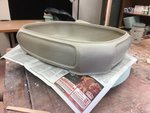You are using an out of date browser. It may not display this or other websites correctly.
You should upgrade or use an alternative browser.
You should upgrade or use an alternative browser.
Building a wet slab bonsai pot
- Thread starter ABCarve
- Start date
ABCarve
Masterpiece
ABCarve
Masterpiece
I’m experimenting with a new form. I like flaring sides but shadows obscure the surface under the flare. I’m hoping this is a solution.
Attachments
-
 0BE361AD-C054-4ED3-BCF8-BEBF6A9204A5.jpeg97 KB · Views: 107
0BE361AD-C054-4ED3-BCF8-BEBF6A9204A5.jpeg97 KB · Views: 107 -
 56457B73-9D52-4A92-8D92-C51DEFA90B7F.jpeg99.8 KB · Views: 101
56457B73-9D52-4A92-8D92-C51DEFA90B7F.jpeg99.8 KB · Views: 101 -
 18FA4479-9AD9-4BD0-9C26-AC808569C1A8.jpeg84.2 KB · Views: 93
18FA4479-9AD9-4BD0-9C26-AC808569C1A8.jpeg84.2 KB · Views: 93 -
 E53FE7DF-88C4-40CA-B86D-4334FEAFF67D.jpeg65 KB · Views: 91
E53FE7DF-88C4-40CA-B86D-4334FEAFF67D.jpeg65 KB · Views: 91 -
 F96C1F48-22F8-46FE-BF8E-C2F6AE4FC5CC.jpeg97.4 KB · Views: 88
F96C1F48-22F8-46FE-BF8E-C2F6AE4FC5CC.jpeg97.4 KB · Views: 88 -
 744A5B48-A22A-4553-AA4E-2FE1F6C84335.jpeg92 KB · Views: 110
744A5B48-A22A-4553-AA4E-2FE1F6C84335.jpeg92 KB · Views: 110
Gsquared
Shohin
Wow, these look great! Really fine work.
ABCarve
Masterpiece
So I thought I'd give a tutorial on how I make foam form plugs. This is a bridge pot I hoping works with my kwansan cherry. I always do a drawing first to let me think the design through and ponder its process. Templates are done with folded paper to maintain symmetry. Bandsaw is very handy!!
Attachments
ABCarve
Masterpiece
Fairing out the any bumps from the bandsaw can be taken out with a sanding board. Since I want the bottom to have soft corners I want to round off the foam with a carving burr and pneumatic drum sander. I save the bottom and top cut-outs for use later to support the wet clay.
Attachments
ABCarve
Masterpiece
penumbra
Imperial Masterpiece
I am truly astounded. I am a potter of sorts and I only wish I had a modicum of your talent. Wow!
penumbra
Imperial Masterpiece
BTW, if you ever decide to do a workshop I sincerely hope you will let me know. I would be there for sure.
ABCarve
Masterpiece
Thank you for your kind words. I think that it’s just taking the time to think the problems through. And the rest is just like playing an instrument..... practice practice practice.I am truly astounded. I am a potter of sorts and I only wish I had a modicum of your talent. Wow!
penumbra
Imperial Masterpiece
And with practice in presence is a practice in patience. Again, if you ever decide to do a workshop please let me know. I am more of a hands on kind of guy. I was thinking about you yesterday when I was loading my kiln.
LanceMac10
Imperial Masterpiece
Very clean lines specially considering the esoteric shapes you've created. Really impressive.
Great work and thanks for the share!
Great work and thanks for the share!
ABCarve
Masterpiece
Patience is nothing more than “time + desire”. Most people are lacking one of those components. I’ll keep the workshop in mind. I do kusamono pot workshops for our club, but I don’t think that’s what you’re looking for.And with practice in presence is a practice in patience. Again, if you ever decide to do a workshop please let me know. I am more of a hands on kind of guy. I was thinking about you yesterday when I was loading my kiln.
ABCarve
Masterpiece
ABCarve
Masterpiece
ABCarve
Masterpiece
ABCarve
Masterpiece
This is how you can use foam as a female mold for texture. This is round cornered rectangle band-sawed out. The texture was created by picking at the foam with my fingernail. The clay is added while the mold is in pieces. First just enough the fill the divots and then squeegeed in with a rib.
Attachments
ABCarve
Masterpiece
The pieces are now assembled by wrapping the perimeter with packing tape. Each corner joint has strike-up marks showing which corners line up with each other. Once assembled the clay gets a light spritz of water and then a slab is added to get an even wall thickness. A bottom is then put in and allowed to set and firm up. Once firm, a loose fitting piece of foam is inserted to support the bottom so it can be flipped over and apply the feet. This pot sat out drying for about 40 hours before removing the foam.
Attachments
ABCarve
Masterpiece
Determining when to remove the foam is trial and error. The foam is soft and the clay is somewhat soft so as not to break the texture. Wiggle the mold at intervals and it will become evident when it ready. You can see where the foam tore out on some of the deeper texture. This would not work with a plaster mold. The finished pot is from the National Arboretum pot show in 2015.
Attachments
Similar threads
- Replies
- 3
- Views
- 139












































